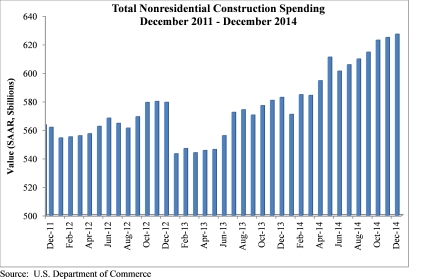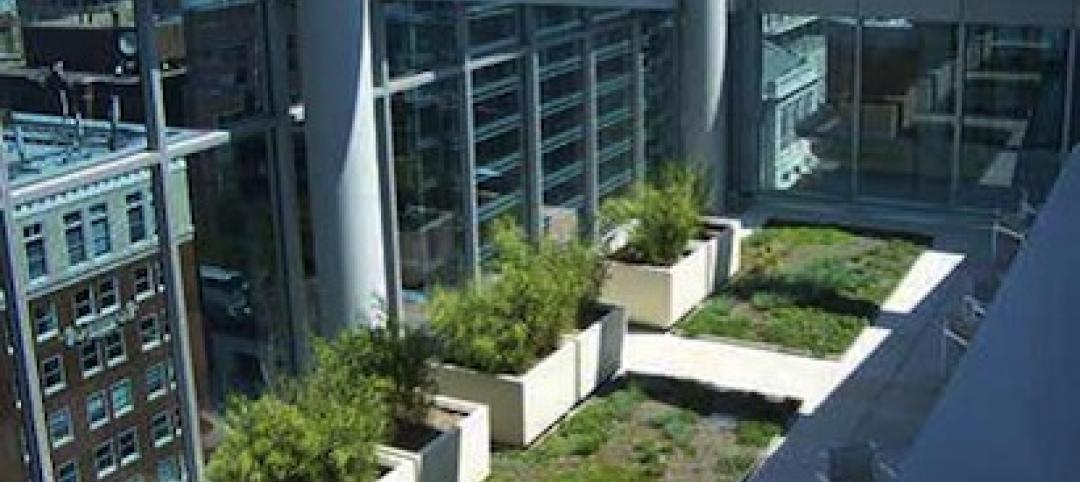Nonresidential construction spending expanded 0.4% on a monthly basis in December 2014, according to the Feb. 2 release from the U.S. Census Bureau.
Spending for the month totaled $627.1 billion on a seasonally adjusted, annualized basis, 5.9% higher than December 2013. The government also upwardly revised November's spending estimate from $617 billion to $624.8 billion and October's figure from $623 billion to $627.4 billion.
"Despite the slight expansion indicated in today's report, nonresidential construction lost some of its momentum during the final two months of 2014; however, this should represent only a minor dip in the industry's momentum headed into 2015," said Associated Builders and Contractors Chief Economist Anirban Basu. "It is possible that the past two spending reports indicate the U.S. economy is not as robust as many analysts believe but it is important to remember that 2014, as whole, was a solid year of recovery for the industry and total nonresidential construction spending was 6.6 % higher than in 2013.

"While some may surmise that the lack of momentum in nonresidential construction spending is related to the sharp fall in oil prices, this does not appear to be the case," said Basu. "Oil-related construction categories like transportation and manufacturing have retained their momentum while categories such as public safety and education have experienced declines in spending. It is also possible that the decline simply represents noise in the data; after all, October and November's figures have been revised higher while the December estimate remains preliminary."
Seven of 16 nonresidential construction subsectors posted increases in spending in December on a monthly basis:
- Communication construction spending expanded 2.5% for the month, but is down 9.5% for the year.
- Highway and street-related construction spending grew 2.5% in December and is up 10.5% compared to the same time last year.
- Power-related construction spending grew 1% for the month, but is 8.3% lower than the same time one year ago.
- Conservation and development-related construction spending grew 1.7% for the month and is up 24% on a yearly basis.
- Office-related construction spending grew 1.7% in December and is up 17.6% from the same time one year ago.
- Manufacturing-related spending expanded by 2% in December and is up 18.1% for the year.
- Amusement and recreation-related construction spending gained 1.9% on a monthly basis and is up 11.9% from the same time last year.
Spending in nine nonresidential construction subsectors declined in December on a monthly basis:
- Healthcare-related construction spending fell 1% for the month and is down 2.1% for the year.
- Education-related construction spending fell 1.2% for the month, but is up 3.9% on a year-over-year basis.
- Spending in the water supply category fell 0.3% from November but is 10.1% lower than at the same time last year.
- Construction spending in the transportation category fell 0.2% on a monthly basis, but has expanded by 9.5% on an annual basis.
- Public safety-related construction spending fell 4% on a monthly basis and is down 9.5% on a year-over-year basis.
- Commercial construction spending lost 1.7% in December, but is up 10.7% on a year-over-year basis.
- Religious spending fell 4.1% for the month and is down 1.3% from the same time last year.
- Lodging construction spending fell 1.4% on a monthly basis, but is up 18.3% on a year-over-year basis.
- Sewage and waste disposal-related construction spending fell 2% for the month, but has grown 10.5% on a 12-month basis.
To view the previous spending report, click here.
Related Stories
| Dec 24, 2013
First Look: Calatrava's Sharq Crossing in Doha, Qatar [video]
The government of Qatar has released details of Sharq Crossing, a massive infrastructure project designed by Spanish architect Santiago Calatrava.
| Dec 23, 2013
MBI commends start of module setting at B2, world's tallest modular building
The first modules have been set at B2 residential tower at Atlantic Yards in New York, set to become the tallest modular building in the world.
| Dec 23, 2013
First Look: KPF's dual-tower design for Ziraat Bank in Istanbul
Kohn Pedersen Fox Associates (KPF) is designing a new headquarters for Turkey’s largest and oldest financial institution, Ziraat Bank, in a modern, suburban district of Istanbul.
| Dec 20, 2013
Top healthcare sector trends for 2014 (and beyond)
Despite the lack of clarity regarding many elements of healthcare reform, there are several core tenets that will likely continue to drive transition within the healthcare industry.
| Dec 20, 2013
Must see for the holidays: Architects re-create iconic structures using gingerbread
Gensler, PBK, Page Sutherland Page, and Kirksey were among the firms to compete in the 5th Annual Gingerbread Build-Off.
| Dec 20, 2013
Can energy hogs still be considered efficient buildings? Yes, say engineers at Buro Happold
A new tool from the engineering firm Buro Happold takes into account both energy and economic performance of buildings for a true measure of efficiency.
| Dec 20, 2013
Ten spectacular contemporary churches [slideshow]
German building-information provider Emporis compiles a photographic tour of inspirational spaces.
| Dec 19, 2013
NRDC report relates green infrastructure investments to commercial property value [Infographic]
The Natural Resources Defense Council has released The Green Edge: How Commercial Property Investment in Green Infrastructure Creates Value -- a first-ever illustrative and well-documented report that helps demonstrate the value of green infrastructure. It draws from available published material to capture the multitude of tangible, monetizable non-water quality and water quality benefits that green infrastructure investments (trees, rain gardens, and porous pavement, rainwater harvesting cisterns, bioswales, etc.) can unlock for the commercial real estate sector, including commercial property owners and their tenants.
| Dec 19, 2013
Mastering the art of crowd control and visitor flow in interpretive facilities
To say that visitor facility planning and design is challenging is an understatement. There are many factors that determine the success of a facility. Unfortunately, visitor flow, the way people move and how the facility accommodates those movements, isn’t always specifically considered.
| Dec 19, 2013
Urban populations, climate change demand resilient design: Report
With over fifty percent of the population already living in urban areas, cities must grapple with the potentially catastrophic effects of climate change (think: Superstorm Sandy in New York). In a new report, Jones Lang LaSalle has identified steps cities can take to make their infrastructure more resilient to changing climate conditions.

















